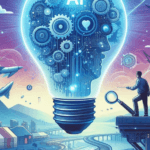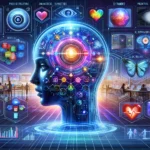Artificial intelligence is evolving rapidly. OpenAI’s latest innovation, GPT-40 Vision, aims to revolutionize our interaction with technology. This AI model combines powerful language capabilities with advanced visual understanding. It creates a versatile tool with immense potential for various industries and daily life. In this article, we’ll explore GPT-40 Vision’s features and its impact on AI’s future.
What is GPT-40 Vision?
GPT-40 Vision is an advanced AI model. It merges text understanding and generation with visual data interpretation. This dual capability allows it to perform tasks requiring both textual and visual comprehension. Imagine an AI that can describe what it sees in a photo, generate images from text, or analyze and summarize visual and textual information together. This is the power of GPT-40 Vision,
making it versatile for many applications.
Key Features of GPT-40 Vision
- Enhanced Language Understanding: The model’s language skills are more sophisticated, generating coherent and accurate text.
- Visual Processing: GPT-40 Vision can analyze and interpret visual data, making it versatile for various uses.
- Multimodal Learning: GPT-40 Vision uses multimodal learning to understand context and nuances that are not apparent when analyzing text or images separately. This means it can perform tasks like image captioning more accurately, providing descriptions that are relevant and contextually appropriate.
- Applications in Different Industries: It is utilized across multiple sectors, from healthcare to entertainment.
Potential Applications of GPT-40 Vision
Healthcare: The GPT-40 Vision could revolutionize healthcare by enhancing diagnostic accuracy and efficiency. It can analyze medical images like X-rays, MRIs, and CT scans, identifying anomalies that human eyes might miss. This capability can assist doctors in diagnosing conditions early, improving patient outcomes.
For instance, in detecting cancer, GPT-40 Vision can highlight suspicious areas in medical images, prompting further examination and potentially saving lives.
Education: In the education sector, GPT-40 Vision has the potential to create more engaging and effective learning experiences. It can generate educational content that combines text and visuals, making complex concepts easier to understand. For example, it can produce interactive textbooks where students can click on images to get detailed explanations or use augmented reality to bring historical events to life.
Entertainment and Media: The entertainment and media industry can greatly benefit from GPT-40 Vision. Its ability to generate high-quality visual and textual content can streamline the production process in areas such as video game design, movie production, and advertising. For example, it can create storyboards based on script descriptions, design characters and settings, or generate promotional materials that combine compelling visuals with persuasive text.
Security and Surveillance: In the field of security and surveillance, GPT-40 Vision’s advanced image recognition capabilities can improve the accuracy and efficiency of monitoring systems. It can analyze video feeds in real time, identifying potential threats and alerting security personnel promptly. This application is particularly valuable in high-risk areas such as airports, government buildings, and public events.
E-commerce and Retail: The e-commerce and retail sectors can leverage GPT-40 Vision to enhance the shopping experience for customers. By analyzing images of products, it can provide detailed descriptions and recommendations, helping customers make informed purchasing decisions. For instance, it can suggest complementary products based on the items a customer is viewing, enhancing the shopping experience and increasing sales.
The Impact of GPT-40 Vision on Society
Job Transformation: The integration of GPT-40 Vision into various industries will inevitably lead to job transformation. While some roles may become obsolete, new opportunities will emerge that require a blend of technical skills and domain expertise. For example, in healthcare, there will be a growing demand for AI specialists who can develop and maintain systems that analyze medical images. Similarly, in education, there will be a need for educators who can create and implement AI-enhanced learning materials.
Ethical Considerations: The deployment of GPT-40 Vision also raises important ethical considerations. Issues such as data privacy, bias, and accountability must be addressed to ensure that the technology is used responsibly. For example, in security applications, it is essential to establish guidelines that prevent the misuse of surveillance data and protect individual privacy.
Accessibility and Inclusion: GPT-40 Vision has the potential to make technology more accessible and inclusive for individuals with disabilities. It can provide assistive tools that enhance their interaction with the world. For example, visually impaired individuals could use applications that describe their surroundings in detail, while those with learning disabilities could benefit from educational content tailored to their needs.
Democratization of Knowledge: The ability of GPT-40 Vision to generate and analyze vast amounts of information can democratize knowledge, making it more accessible to people around the globe. This is particularly important in regions where access to quality education and information is limited.
Challenges and Future Directions
Technical Challenges
While the potential of GPT-40 Vision is immense, several technical challenges need to be addressed. Ensuring the accuracy and reliability of image recognition and natural language processing remains a priority. Additionally, integrating these capabilities into scalable and user-friendly applications requires significant computational resources and expertise.
Research and Development
Continued research and development are essential to overcoming these hurdles and realizing the full potential of the GPT-40 vision. This involves investing in advanced algorithms, improving data processing techniques, and enhancing the overall performance of AI systems.
Privacy and Security Concerns
The use of visual data raises significant privacy and security concerns. Ensuring that user data is protected and used ethically is paramount. This involves implementing robust security measures, obtaining informed consent, and providing transparency about how data is used and stored.
Conclusion
The GPT-40 Vision represents a significant leap forward in artificial intelligence, offering transformative potential across various industries and aspects of daily life. As we continue to explore and develop this technology, it is crucial to address the ethical, technical, and societal challenges it presents. By doing so, we can unlock the full potential of GPT-40 Vision and usher in a new era of AI-driven innovation.
For more interesting topics, make sure you watch the recommended video that you see on the screen right now. Thanks for reading!
More from Blog
Artificial Intelligence: Introducing Its Basic in a Nutshell
What is artificial intelligence?A primer on AI, its definition, and its significance.Artificial intelligence (AI) is a branch of computer science …
Skyrocket Affiliate Outreach With AI – Scale Your Biz Now
As the digital landscape evolves, businesses must adapt to remain competitive and foster growth. One aspect that is seeing significant …
AI Discovery Journey: Exploring The World of Artificial Intelligence
Introduction to Generative AIArtificial Intelligence has rapidly transformed from science fiction to a central part of our technological reality. Among …
AI Image Generation: The Ultimate Guide to Creating Stunning AI Art [2024]
AI image generation has revolutionized how we create visual content. In this comprehensive guide, we'll explore Envato's AI ImageGen tool, …
AI Discovery Journey GPT: How to Effortlessly Explore It?
IntroductionThe "AI Discovery Journey GPT" is an exceptional tool that caters to a wide range of users, from beginners to …
WebCrawlerGPT: Overview of Key Capabilities for WebCrawling.
WebCrawlerGPT is an advanced AI model that helps users build web crawlers in Python. It offers deep insights into web …
















